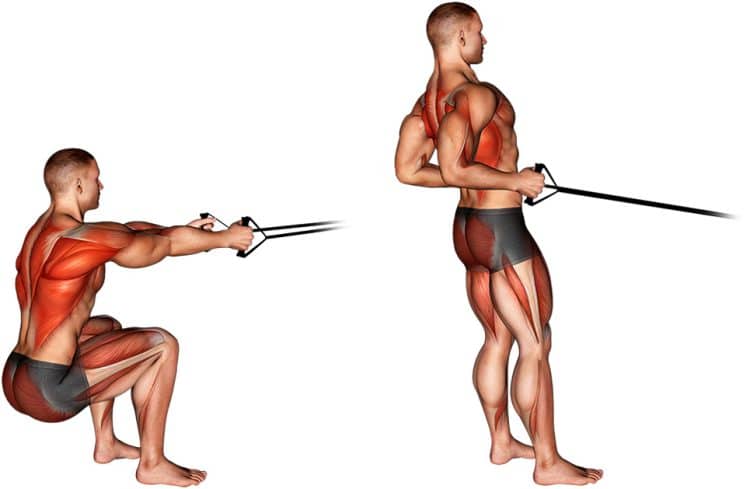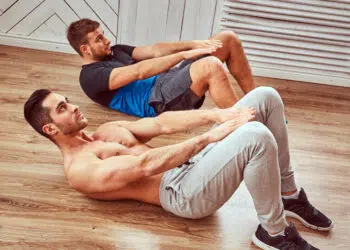Nothing says ultimate home exercise like a band squat row (Although it’s a solid gym exercise too). Two compound movements squeezed in one, and no added resistance in the entire movement (Until you stretch the band). Anchor your band to anything at the appropriate height, use your body weight to train your legs, and create the ideal loading patterns as you challenge your back muscles. A very beginner-friendly exercise, band squat rows offer a supported squat and low-stress upright row variation that saves your lower back. Yet have the capability to build a stronger and more muscular upper posterior chain.
Let’s jump into this training guide, and try the band squat row!
Muscles Worked During Band Squat Rows
Is there a muscle not worked during band squat rows? As you can see there’s a lot of movement going on and every joint is activated which means full-body muscle stimulation. Band squat rows may not as blatantly train the push muscles (Chest, shoulders, and triceps), but believe us, they’re working too. Just not in as much of a beneficial manner as the primary muscle groups.
Here’s a brief section on the anatomy of primary muscles worked in the band squat row.
Legs
You could squat and do nothing else, and it’d be sufficient to build all of your leg muscles. Bending the knees and dropping into a squat requires the hamstrings, while the two opposite actions hit the quadriceps, thigh extension comes from glutes, and the calves plantarflex the foot.
Level Up Your Fitness: Join our 💪 strong community in Fitness Volt Newsletter. Get daily inspiration, expert-backed workouts, nutrition tips, the latest in strength sports, and the support you need to reach your goals. Subscribe for free!
Back
Row variations have shown to be the most symmetrical back exercises (1), likely due to the pull occurring toward the center of the torso, fairly stimulating the lower back, lats, rhomboids, scapular muscles, trapezius, and rear delts. These muscles move the shoulder blades, and arms and allow us to maintain proper postures.
Deltoid Posterior
The primary benefit of your rear-facing shoulder head is to draw the arms behind you which occurs during a row. Usually underdeveloped, the posterior delts can’t get enough of that rearward action!
Core
Forget it… without a strong core you’re not doing much. These abdominal and lower back muscles in the center of your body create a second base of support above the legs and glutes. They control flexion of the upper body, and stiffen the midsection during heavy lifts, and high impact physical activities.
How To Do The Band Squat Row
If you can squat and row, then you’re capable of combining the two. They’re relatively basic movements that everyone learns as a novice exerciser. But make sure you’re doing them correctly, dropping straight down or slightly back, keeping your weight over center foot or heel, and using your back muscles to create resistance.
For your convenience, we’ve provided step-by-step band squat row instructions with a video example afterward.
Steps
- Secure one end of your band to a stable base at a height roughly somewhere between the belly button and hips.
- Grab the band in both bands then walk backward facing the base with your arms extended forward, until the band stretches.
- Come into a roughly shoulder width stance and turn the toes slightly out.
- Keep your back straight, chest up, and core tensed.
- Bend your knees and slowly drop your butt down until your upper legs are right at or lower than parallel, depending on your flexibility.
- Push through your feet and stand straight up out of the squat.
- To perform the row, draw your shoulders back, bend your elbows, and drive them behind your body while pulling the handles into your sides.
- Straighten your arms forward, complete another squat, row, then continue this sequence for the desired number of repetitions.
Check out the video tutorial below that includes the basic version and a few simple variations.
Tips
- Adjust the cable pulley to a high or low position for a different feel, or to emphasize different parts of your back.
- Bring your arms higher to emphasize more of the scapular muscles like traps and rear delts. Keep your arms lower to target the lower traps, lats, and lower back muscles.
- Challenge yourself with the resistance. You can go pretty heavy with this variation.
- Your feet should remain in the same spot both for the squat and row.
- Pick up the tempo for cardio fitness workout.
6 Benefits of Band Squat Rows
Double the movement, double the benefits. There are some great advantages to this two-in-one technique.
Time-saving exercise combination
Legs and back make for a great duo. Two of the largest muscles in the body would otherwise require separate days due to the intensity required to train them thoroughly. But squat band rows are better geared toward cardio resistance based training sessions. Especially if you do them at a faster tempo.
These are great for fitness classes or when you have very limited time to get in a workout, and don’t want to overstress your system with heavy weight loads.
Perfect entry level movement
What’s more basic than a squat and band row. Two essential movement patterns that every beginner learns within their first few workout sessions. Fundamentally necessary for many other variations, and movement patterns, we like the beginner friendly nature of band squat rows.
Additionally, while they have the potential to work you up a sweat, the lack of heavy loading is easier on the nervous system, and wont take as much out of you.
Experiment with different positions
Get your mind out of the gutter… we’re talking about playing with different positions in the band squat row (Nice try though).
Save your lower back for another day…
A super benefit of bands not often talked about is the relief on your lower back. You see, even if you perform a bent-over band row with your feet anchoring the band down, it’s not going to stress the body like holding a heavy barbell.
Then take the standing band squat row (The primary exercise example of this guide), and you significantly reduce the stress on your lower back in an upright position. Plus, you cannot use max loads with this variation anyway. Therefore, it is a great overall movement for most people.
Level Up Your Fitness: Join our 💪 strong community in Fitness Volt Newsletter. Get daily inspiration, expert-backed workouts, nutrition tips, the latest in strength sports, and the support you need to reach your goals. Subscribe for free!
Prevent training boredom
Anything can get boring after a while. The answer is to simply do something different. Not forever, just once in a while to keep things new and fun. Even pro athletes and bodybuilders like variety in their training. It keeps us looking forward to those subsequent training sessions.
All you need is a resistance band
Incredibly accessible to anyone, you don’t need a gym membership or weights to do band squat rows. And bands are totally affordable these days. You don’t even need much space either, and you can do it indoors or outdoors.
Common Mistakes During Band Squat Rows
While hyping band squat rows is justifiable, there are also some tempting drawbacks and common mistakes you should avoid making.
Leaning too far back
Don’t use your band as a crutch… literally. Instead engage your core and leg muscles to fight against the resistance pulling you back. It’s tempting to want to lean back and let the band hold you up. And this can work as long as you’re not treating the bands as a suspension trainer, which is another excellent variation also shown later on.
Using the wrong band resistance
This one can get a little tricky if you’re not experienced in your training. You’ll need to find a balance between using the band for balance, and challenging your back muscles too. So choose a band that’s strong enough to hold you in place, but that allows you to get a good posterior workout in a 7-20 rep range.
5 Variations of Band Squat Rows
We have to admit, it was challenging coming up with some of these variations due to the uniqueness of a band squat row. But we found some good similar movements that you transition right into, each of which have their own benefits.
Static squat row
For this variation, you’ll drop into a squat and stay there while you crank out a set of rows. You’ll be challenging the leg muscles isometrically instead of isotonically, which offers many of the same strength building benefits, and builds mental fortitude.
Related: The science of isometric training – explained!
Tempo squat row
You can also turn this combo technique into a fat burning activity with tempo training. This example is also shown in the primary video demonstration under ‘How to do the band squat row’. It tacks on two additional elements from the standard version. Faster rep speed, and simultaneous concentric movements.
Steps
- Setup for the squat row like normal.
- Squat down.
- Then as you stand up, simultaneously perform a row.
- Drop back down into a squat and straighten your arms forward.
- Repeat steps 3 and 4.
- Continue the movement for as many reps as desired.
Band squat row w/ weighted vest
Band squat rows use no extra resistance for the legs. It’s a bodyweight only leg movement. If you’re more advanced, you can wear a weighted vest or backpack for additional resistance, while your hands are tied up with bands. This is an excellent home training strategy that allows for progression without weights, machines, or bands.
Cable squat row
The same applies to a cable squat row, no external resistance for the squat. You can’t go extremely heavy as the cables will pull you back toward the machine, throwing off your form. But you do want to choose a weight heavy enough that requires core engagement to stay in place, and that also challenges your back muscles too.
What we really like about cable squat rows is that you also get the luxury of choosing from different attachments like a rope, single grip, long bar, etc.
TRX squat row
While the same variation with a suspension trainer involves a little more setup, it comes with its own unique benefits. Most notably that the straps don’t bounce or stretch. Additionally, even though your body is the resistance, you can choose the exercise difficulty with the position of your feet.
For example, the closer your feet are to the anchor point, the more resistance is created as your body works harder against gravity. The opposite is true when the feet are farther away from it.
Check out our full suspended row training guide.
Below are two examples of how you can perform TRX squat rows.
Tips
- Adjust your suspension straps to roughly mid length for this variation.
- Try to maintain strong scapular retraction by holding your shoulders back, and not allowing the arms to protract too far forward.
Related: Best TRX Back Exercises For A Thick Rock Solid Back
FAQ’s
How many sets and reps should I do to build muscle and strength?
Use bands that challenge you in a rep range of 8-25. Sets depend on your training frequency but at a minimum, we recommend 2-4 per workout session.
What band strength should I use for squat rows?
This will depend on your level of training experience and strength capabilities. You want to be able to perform rows will full range of motion, but the band should also be able to support your balance during the squat.
Should beginners do band squat rows?
Absolutely. However, it’s important that beginners remember not to depend on the band for supporting or holding themselves up during the exercise.
What are band squat rows best used for?
A versatile exercise, do band squat rows as part of a home fitness routine, and aim for high repetitions to build muscle, and endurance. Or, strap on a weighted vest or backpack, and focus on building stronger, bigger legs, while you achieve next level back gains with heavy band rows.
Band squat rows are exciting to throw in your training mix, saving you time, and offering an excellent minimalist multi-muscle group exercise alternative.
Wrapping Up
If lately you’ve been bored of your training or wondering how you can get excited about leg day, well, look no further than band squat rows. No weights or gym needed, it’s a minimalist, total body technique that’s able to give you strength, muscle, and endurance without killing your lower back, or needing to mentally prepare yourself to lift heavy weights. Bands offer built in resistance that increases with your range of motion, giving you a lower impact workout that can be modified to your performance level.
Not to mention, the many other delicious variations you should try too!
Interested in measuring your progress? Check out our strength standards for Upright Row, Squat.









